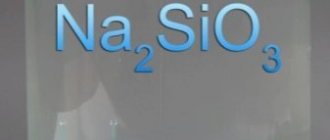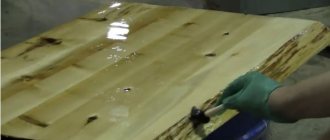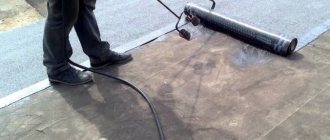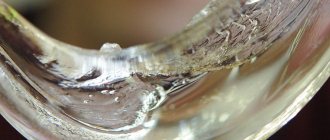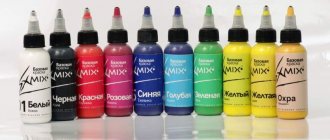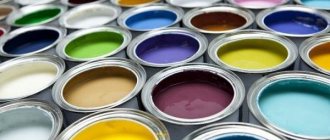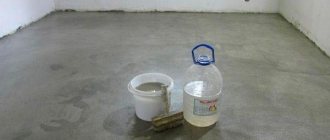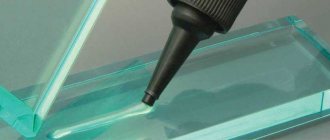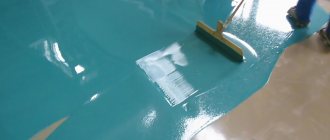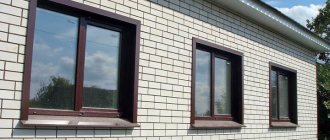Due to increased air humidity, constant exposure to moisture on the floor, walls and even ceiling, the bathroom is exposed to various harmful effects. These include the appearance of mold and mildew, the growth of bacteria, which causes an unpleasant odor, as well as the destruction of wall, floor and ceiling materials, especially if they are made of wood. The absence or poor waterproofing of a bathroom in an apartment can lead to constant leaks. To avoid unpleasant consequences, you need to carry out waterproofing work in the bathroom correctly and efficiently.
Types of waterproofing
Waterproofing materials are laid between the base of the room surfaces and the decorative trim in all areas where contact with water is possible. To decide which waterproofing is best for a bathroom, you need to consider its types.
Pasting
This type includes roll or film materials made from cardboard or synthetic fiber impregnated with bitumen. The roll is cut into separate strips, laid on the surface and heated with a gas burner, after which the material melts, firmly adhering to the floor.
Disadvantages: roll waterproofing is not suitable for use in a small, unventilated room, since a gas burner cannot be used under such conditions. The joints of the strips must be sealed with silicone or polyurethane sealant, otherwise they will allow moisture to pass through. Inconvenient during installation.
Advantages: in addition to those materials that need to be heated, there are waterproofing materials that themselves adhere to the surface. Such materials are reliable and convenient to use. In addition, roll insulation is cheaper than other types.
Coating
These are thick compositions in the form of powder, paste, mixture based on bitumen, sand or cement with the addition of various polymers.
Coating materials for waterproofing a bathroom come in two types: one-component and two-component. The first type contains water and waterproofing agent, and the second includes polymer binders. Two-component waterproofing, in addition to protecting against moisture, contains substances that protect the surface from the formation of fungus and mold.
Disadvantages: bitumen mastic can crack due to temperature fluctuations, and it also has an unpleasant odor during application. In addition, it is worth noting the long drying time of the waterproofing layer, reaching three days. It is necessary to apply several layers, each of which must dry for at least 6-8 hours.
Advantages: coating waterproofing for the bathroom with various plasticizers and polymers has a composition that penetrates into all cracks and cracks, filling them and protecting them from water penetration. Easy to apply. The adhesion coefficient of the mastic allows it to be applied to hard, flexible surfaces. Coating materials combine well with the “warm floor” system and are able to withstand elevated temperatures.
Liquid formulations
Liquid waterproofing for the bathroom is used to cover walls, floors, and ceilings. It is available in two types: liquid glass and liquid rubber. Liquid glass consists of a solution of potassium and sodium, fills the pores on the surface of concrete or wood without forming a film. Liquid rubber is a bitumen emulsion diluted with water. Absorbing into the surface of the floor or walls, it forms a reliable top protective layer.
Disadvantages: liquid waterproofing of the bathroom floor is done only under the screed.
Advantages: liquid waterproofing of bathroom floors is universal in relation to various types of surfaces. This material has a high coefficient of adhesion to various coatings, is resistant to various aggressive environments, and can be used to insulate walls or floors where there is constant contact with water.
Areas of application of liquid glass
Sometimes this substance is used to impregnate the surface to avoid the appearance of fungus and mold, which occur with constantly high humidity in the room.
If you decide to line the walls with PVC material or lay linoleum on the floor, you can also use this glass, since it also has the properties of glue. Also, liquid glass can perfectly replace glue when connecting or sealing pipes, but in this case it will not be possible to disassemble it to replace parts. If your furniture is broken and you only have liquid glass on hand, you can safely use it instead of glue, because it is even suitable for gluing furniture.
Choosing the right waterproofing material
To get high-quality work on applying a moisture-resistant coating to a bathroom in a frame house or apartment, you need to know what kind of waterproofing to choose for the bathroom and how to install it correctly. So, the best waterproofing for the bathroom is selected according to the recommendations:
- To lay tiles on a concrete base, it is recommended to use a coating mastic. They are easy to use, withstand temperature changes, and are suitable as a base for screed. Coating materials are also best used if the surface area to be treated does not exceed 10 sq.m.
- Liquid rubber is suitable for use in the bathroom, regardless of the finishing material.
- Waterproofing bathroom walls is often done using cement-polymer compounds. This material is excellent for tiling.
- Waterproofing the ceiling in the bathroom, as well as the walls, can be done with liquid glass - this plastic composition forms a thin surface that protects against moisture, fungi, mold, without weighing down the wall surface.
- Waterproofing a bathroom in a wooden house is conveniently carried out using roll materials, and protecting the floors under the bathroom floor is done using coating mastic.
- Waterproofing drywall in the bathroom is carried out using coating compounds, on top of which tile adhesive and the tile itself are applied. Coating mastic is also ideal for covering plaster walls in the bathroom.
In this case, it is always possible to combine different types of materials. For example, to cover a large area of the floor surface, roll waterproofing is used, and for the walls of the same bathroom, coating or liquid insulation is used.
No. 6. Liquid glass for concrete waterproofing
The popularity of liquid glass is associated precisely with its addition to concrete mortar. The essence of the method would seem to be clear, but to get a truly high-quality result, you need to know several nuances:
- Liquid glass cannot be added to the prepared liquid solution. First, prepare a dry mixture, and then dilute it with water, to which a certain part of liquid glass is added;
- the amount of liquid glass can vary widely - it all depends on your goals. Having chosen a specific recipe, it is very important to follow the specified proportions. The minimum content of liquid glass in concrete is 2% (this composition is used for waterproofing the foundation), the maximum is 25%;
- liquid glass improves the quality of the solution, but greatly affects the speed of its hardening. It is recommended to prepare the solution in small portions so that it does not harden while still in the container. For the same reason, many do not recommend using a concrete mixer.
If you add only 2-3% liquid glass to the solution, the concrete will begin to set within 45 minutes, and will completely harden after a day. This is a fairly popular proportion. When adding 5% liquid glass, the setting speed will be reduced to 30 minutes, and complete hardening will occur after 16 hours. For 8% these figures will be 15 minutes and 7 hours, and for 10% - 5 minutes and 4 hours, respectively. For mixing, use clean cold water and cement grades M300 and M400.
The mixing principle is as follows:
- take a container with clean water, add liquid glass there, mix;
- the solution is poured into a larger container and a dry cement-sand mixture is gradually introduced;
- quickly but thoroughly mix the mixture until smooth and get to work.
All work is carried out in special clothing and gloves.
Waterproofing a bathroom in a wooden house
Waterproofing the floor and walls in the bathroom of a wooden house can combine not only treatment with water-repellent compounds, but also the use of water-resistant wood species for finishing.
Waterproofing drywall in the bathroom is not required if you use moisture-resistant material or aquapanels. They do not allow moisture to pass through; you just need to treat the seams with sealant or glue.
Waterproofing a wooden bathroom in a private house is carried out with special care in those places that are subject to constant interaction with water: the ceiling, walls above the shower stall, near the sink, toilet, around the bathtub and the entire floor surface. To waterproof the ceiling, you can use film material or regular polyethylene film attached with a construction stapler, as well as coating mastic. It is imperative that a vapor barrier material be attached to the beams above the ceiling.
Waterproofing of a wooden floor in a bathroom is carried out at two levels: on the joists under the rough flooring and under the screed before laying the flooring. Many experts agree that it is better to use rolled material, and treat the corners, pipe outlets and sewer holes with a coating compound extending onto the walls by 20-30 cm, covering the edges with sealing tape. Sealing of seams between the joints of strips of rolled mastic should be done using glue.
Thus, high-quality waterproofing in the bathroom with your own hands will allow you to avoid many problems associated with constant exposure to water and high air humidity in the bathroom, and a wide selection of materials will help create a comfortable atmosphere.
The need for waterproofing measures arises during the construction process. It is no less relevant in cases where repair and restoration work is carried out. Thanks to the use of modern technologies and materials, waterproofing can be carried out on vertical, horizontal surfaces, and structures of complex shapes. In order to get the maximum result, you should choose the right insulating material and strictly follow the technology for its application. The choice should be based on the operational and structural features of the building. The most popular nowadays are roll and coating (liquid) waterproofing materials.
Moreover, the last group is considered the most extensive. It is accompanied by a whole range of compositions made in the form of mastics, pastes, paints, impregnations, etc.
The main task performed by liquid waterproofing is to protect the surface from moisture penetration. With its help, you can process the most complex and uneven areas (basement walls and ceilings, foundations, roofing with parapets, seams, ventilation and antenna outlets, abutments and much more).
Based on the type of composition, liquid waterproofing is divided into:
– dry mixes and mastics. The insulating composition is obtained by mixing binding components, additives and fillers. The heat resistance and flexibility of such mixtures make their use quite wide, from injection (spot) and joint insulation to general waterproofing of surfaces; – water repellents. These are special compounds that, after application, form a protective, durable film that does not allow moisture to pass through. Using water repellents, you can treat surfaces without prior preparation; – penetrating liquid waterproofing. It fits perfectly on any type of surface, filling microcracks and pores. When moisture enters, a chemical reaction occurs, resulting in the growth of crystals, which fill cracks and damage.
Advantages and disadvantages
The protective layer is short-lived; after just a year, the coating loses 1 mm.
The service life of liquid glass, according to the warranty card, is 5 years. During use, it was noticed that after this period the coating begins to gradually deteriorate, losing 1 mm of thickness every year. To extend the service life, it is recommended to apply a layer of paint on top of the waterproofing.
Sometimes liquid glass is added to the concrete mixture for its strength
The material qualitatively fills cracks and pores in concrete, plaster, brick, wood and other materials.
To increase the strength and abrasion resistance of the cement mortar, 1 to 10% liquid glass is added to it, not forgetting that the setting time of the mortar is significantly reduced. If you increase the dosage, the coating will become fragile and unstable to mechanical damage.
For a person who does not have experience working with this material, it may be difficult to apply it.
Liquid glass hardens within 30 minutes. If you dilute more material than you have time to apply it to the floor, the glass will harden and will be unsuitable for reuse.
Liquid glass - all the pros and cons
The most popular among other compounds used for waterproofing are liquid glass and liquid rubber. Their undeniable advantages over rolled materials include:
– the ability to process foundations and other surfaces of complex shapes; – the ability to form a continuous coating without seams and cracks; – higher moisture resistance compared to bitumen compositions; – non-toxic, – do not “float” in the heat; – do not ignite; - do not require preheating; – provide high adhesion to the surface being treated.
Liquid glass has found wide application for waterproofing various surfaces due to its almost instant crystallization. The working solution is applied very quickly, with complete setting of the material occurring within a maximum of 30 minutes. Its undeniable advantage is the ability to use it in wet conditions. Liquid glass completely fills cracks and damage, forming a waterproof film.
When working with this material, it is very important to follow the dosage. If mixed with concrete or other compounds, it is very important not to exceed the dose. The result of such an error may be a “tear” of seams and joints.
Methods for waterproofing a foundation with liquid glass: – coating. The protective composition is applied to the surface of the foundation using a special roller, brush or brush. If further installation of rolled materials is planned, then liquid glass is diluted according to the instructions and applied using a spray bottle in two layers. The depth of penetration of the composition into the foundation is 2 mm. In this case, cracks and micropores are filled. – processing of seams and adding liquid glass to the cement mortar. If the house has a prefabricated foundation, additional treatment of the seams with a composition that includes cement and liquid glass will be required. – injection. To restore the foundation, injection waterproofing is carried out with the same liquid glass. To do this, holes are created in separate parts of the base (preferably from the inside) using a perforator, into which the mixture is subsequently pumped.
Proportions of components when using liquid glass
Commercially available silicate composition contains a small amount of water, sufficient to maintain a saturated liquid solution. When independently preparing building mixtures, the commercial product and other components are mixed, adjusting the consistency by adding water. For construction and repair purposes, a number of compositions containing cement, sand and other additives are prepared.
Do-it-yourself waterproofing solution preparation technology
When creating a waterproof layer, a mixture of liquid glass and cement or concrete mortar is used in a volume ratio of 1: 10. Working with liquid glass is quite simple.
If cooking instructions indicate proportions of components taken by weight, density values should be used (volume is the ratio of weight to density):
- liquid glass – 1.5 kg/l;
- cement-sand mortar (1: 4) – 2.6-2.7 kg/l;
- concrete solution - 2.2-2.5 kg/l (for the most common heavy concrete);
- quartz sand - 1.5-1.7 kg/l (1.7 for compacted sand, 1.5 for loose sand).
The resulting mixtures are used to fill floors and increase the waterproofing properties of walls. To increase the waterproofness of floors and increase their strength properties, you can fill the outer surface with an additional layer of liquid glass. The thickness of the silicate layer should be about 3 mm and applied in one go - this will ensure maximum strength.
When waterproofing the walls of wells, a solution of liquid glass with cement and fine sand, taken in equal proportions, is used. The resulting mixture is applied to the walls of the well, previously coated with diluted silicate.
If the surface was impregnated with a pure silicate mixture before applying the coating, do not wait for it to completely harden. A monolithic glass-like surface may prevent normal adhesion to the primer or plaster.
Painting works
The color range of silicate paints is low. This is due to their high alkalinity, which leads to the destruction of many pigments. In the production of paints, potassium silicate is usually used - the resulting mixture forms a more stable and uniform structure with coloring pigments.
Silicate paints are sold ready-made or come as separate components that must be mixed before use (liquid glass and pigment). To increase hydrophobicity, small additions of organic polymers (up to 5%) can be added to the composition.
If the surface has previously been painted with an alkyd or acrylic composition, it must be thoroughly cleaned. The best adhesion of silicate paint is obtained with a surface previously treated with lime whitewash or cement composition.
Palette of silicate paints
Exterior works
Waterproof plaster is used to protect wall material from the damaging effects of moisture. The use of hydrophobic plaster in northern regions is of particular importance, since frequent freezing and thawing of water inside the material leads to the appearance of cracks.
For self-preparation of plaster, the optimal proportion of liquid glass, cement and sand is considered to be 1: 2: 5. Before work, as when waterproofing wells, the walls can be pre-coated with diluted silicate.
Padding
In home construction, it is sometimes necessary to prime a concrete screed. The solution used consists of liquid glass and cement in a ratio of 1 to 1. If a layer of tiles is planned to be applied on top of the screed, it is enough to prime with a diluted solution of liquid glass.
The resulting layer impregnates the surface by several millimeters and increases its strength. For laying tiles, you should buy special waterproof cements or use silicate solutions to waterproof the joints.
Surface impregnation
Liquid glass can be applied to concrete or wooden structures with a brush or spray. In the latter case, the silicate mixture is dissolved with water in a ratio of 1 to 5, and its consumption is significantly reduced. Wood is treated with liquid glass to protect against mold and fungi, as well as to increase fire resistance.
The applied silicate layer must be located outside - in this case its protective properties will be maximum. If the wooden elements are small, they can be completely immersed in a solution of liquid glass - this way maximum strength and uniformity of the coating is achieved.
Concrete surfaces and block walls can be coated with an intermediate silicate layer before applying plaster or a layer of tiles. The outer layer of liquid glass protects the surface from mechanical damage, exposure to acids and mold formation in places where moisture accumulates.
Impregnation (coating) of concrete with liquid glass
How to use liquid glass for repair work - filling cracks, crevices and voids
The repair mixture consists of liquid glass, cement and sand in a ratio of 1: 1: 3. The resulting solution is quite thick and does not have time to flow out of wall defects, and the high silicate content leads to rapid setting.
Brief instructions for use and working with liquid glass:
- do not neglect the use of protective equipment - glasses and gloves are necessary. Due to the high alkalinity of silicates, ordinary clothing can quickly become unusable, so it is better to use workwear made of rough tarpaulin or rubberized fabric;
- If necessary, splashes or spills of material can be removed mechanically. Frozen drops of glass are cleaned off with a knife or blade. To facilitate mechanical cleaning, the area can be covered with a wet cloth for several hours.
- Cleaning up large spills of silicate is not an easy task. It is better to work carefully and clean up promptly, not allowing the spilled solution to harden;
- Liquid glass coatings must be renewed every 3-5 years. This will ensure their high strength properties and appearance. Re-coating is easier - similar materials easily “grab” each other.
How does hydrophobic coating using liquid glass work:
Waterproofing the floor with liquid glass
To obtain a hydrophobic solid coating, it is recommended to apply liquid glass to the floor. Activities are carried out in the following order:
– portions of the solution are poured onto the concrete screed in strips located parallel to the wall; – using a spatula, the solution is evenly distributed over the surface to be treated; – the floor is rolled with a roller to eliminate bubbles and unevenness; – alignment is carried out with a squeegee.
The layer thickness should be 3-5 mm. Remember that the solution should be applied within 30 minutes, so carefully calculate the amount of the mixture. Flooring in one room should be done in one go. After the coating has completely dried, you can apply a layer of polyurethane or epoxy varnish. This will give the floor a special shine and transparency. The surface can be used only by knocking. If there is a “warm floor” system under the floor covering, it is recommended to start using it no earlier than after 7 days.
Recommendations for applying liquid glass
It is recommended to apply any solution to a previously prepared surface. In this case, the adhesion of materials increases significantly.
Prices for liquid glass TEX
liquid glass TEX
When waterproofing the foundation, liquid glass is applied in the following order:
- If liquid glass is used to waterproof a concrete screed or foundation walls, then their surface must first be leveled, dried and cleaned of dust. If liquid glass is applied to a damp screed, it will begin to peel off from the surface.
- Then, liquid glass, diluted to the required state, is applied to the surface of its walls (floor) using a roller. The solution must be distributed evenly over the surface, without leaving untreated “islands”.
- If you plan to strengthen the concrete to a depth of three millimeters, then a spray gun, roller or wide brush is used to apply the composition. In this case, the solution is applied in one layer.
- If the concrete surface needs deeper impregnation (and this is the best thing to do), then the silicate solution will have to be applied to the surface in three layers. After the first layer has been absorbed and dried, it is necessary to apply a second and, if necessary, a third layer of solution. Each of them must dry for at least 30 minutes.
- When the silicate impregnation has completely dried, you can begin insulating the foundation.
Waterproofing impregnation of screed and concrete foundation with liquid glass
If the previous layer was applied as a waterproofing primer, then the next stage is the application of a protective concrete layer, also containing liquid glass. The solution for it is prepared from sand and cement, to which a silicate composition is added. The components are taken in a ratio of 3:1:1 or 3:1:0.7. The procedure for mixing the solution does not differ from that described above.
Exposed beacons for subsequent installation of leveling waterproofing screed.
- To make the coating even, beacons made of metal guides are placed on the surface of the primed base, which are adjusted according to the level. The height of the beacons will correspond to the thickness of the leveling layer. It is also advisable to make slides for fixing beacons from the same cement sand mortar with a silicate additive. It will set quickly, so you won't have to wait long.
Leveling concrete-silicate mortar along beacons
- The concrete-silicate layer can have a thickness of 30÷50 mm. The solution is applied above the installed beacons and leveled using a construction rule or a wide spatula.
The solution should be prepared in portions so that it does not have time to set before it is leveled. Well, when distributing the solution you will have to show some skill.
Bathroom waterproofing
The use of this composition allows you to reliably protect the room from moisture and aggressive alkalis. Using liquid glass, waterproofing a bathroom can be carried out in the shortest possible time. In this case, not only the surfaces of walls and floors are treated, but also seams and joints in cast iron pipes are sealed. Using this material you can reliably protect metal fittings from corrosion and get rid of leaks. In addition, the composition is used to isolate communications supplying drinking water, which significantly expands the scope of its application.
Bathroom surfaces can be treated with liquid glass in several ways. But before starting work, the surface should be leveled and degreased. If impregnation of a concrete surface is intended, the solution should be applied in several layers. This will make it possible to provide a penetration depth of up to 20 mm. In addition, liquid glass can be used for waterproofing pipeline joints, as well as as a universal adhesive for laying a wide variety of materials.
One of the important stages of bathroom renovation is waterproofing, and here homeowners are often faced with the question of what is best to use under tiles to build a reliable and durable bathroom water barrier.
What will form on liquid glass and how?
Forms a sliding-smooth non-absorbent surface. Standard finishing materials will have absolutely no adhesion to such a base. What to do? Advice from finishers who worked with liquid glass:
- use primers over old paint - designed to solve the problem of finishing glossy, non-absorbent substrates;
- use specialized glue: certain types of adhesives for complex substrates, glue for laying on old tiles, for porcelain tiles.
How to remove liquid glass Liquid glass applied to the surface can simply be washed off with water. Since the product does not crystallize after application, but simply dries. Water for an aqueous solution of sodium silicate (SA) is a solvent.
Liquid glass in the USSR
- Used to produce a waterproof solution that was used to seal sewer pipes.
- We covered the base before laying the linoleum to eliminate dust in the seams between the linoleum and the baseboards and achieve a beautiful floor finish.
- Liquid glass was added to masonry mortars. Heat resistant product. When sintered, it also becomes waterproof.
- Wooden materials (internal elements of frames, finishing elements) were covered to protect against burning: it provides temporary protection, which, for example, will allow you to leave the house in case of fire.
Liquid glass in industry. Areas of use
- In the textile industry it is used for bleaching fabrics during dyeing.
- In soap making.
- In the foundry industry.
- In construction.
- In the paper industry.
- In water treatment and water purification systems.
- In the chemical industry.
- To strengthen the soil (in the case when buildings are erected in places with fine sand, quicksand, it is necessary to protect the foundation pit from groundwater, etc.), injectors are driven into the soil and with their help, gel-forming solutions with liquid glass are introduced under the soil - these are methods of soil silicification; are used in industry, as they have a significant price).
- In the paint and varnish industry, non-flammable silicate paints, etc. are created based on the product.
Our company provides liquid glass produced in accordance with GOST 13078–81. The declared characteristics correspond to the “standard” brand.
Historical reference
The product was born at the beginning of the 19th century. in Germany. It began to be used en masse in production instead of rosin - in soap making in North America, when the civil war was in full swing. And since then it has been actively used in a variety of industries; in construction, it imparts heat resistance and waterproofing properties to mortars.
Which areas need waterproofing?
Waterproofing must be carried out over the entire floor area with a minimum overlap of 20-30 cm on the walls. Wall-mounted moisture protection is needed in the area of the bathtub, washbasin, shower and other plumbing fixtures that are installed here. In this case, the wall must be covered with waterproofing for at least 50 cm to the sides and upwards from the extreme sides of the plumbing, in general, wherever there is a high probability of moisture getting on the tiles. Along with this, it is advisable to waterproof the inside of the plumbing cabinet, where the common culprits of leaks are located: water supply and sewer risers.
Types of coating waterproofing
Materials for coating waterproofing are sold in the form of dry or granular powders, semi-dry pastes, or in ready-to-use liquid form. Also, coating mixtures can be one-component or two-component, the latter, as a rule, are quick-drying and more elastic.
- Bitumen-polymer mastics are sold in finished form. They are made from bitumen binder and polymer fillers. This is an excellent insulating material that has high elongation and recovery rates, is non-toxic, odorless, resistant to temperature changes and aggressive environments. You can use bitumen-polymer mastic under tiles only on the bathroom floor, subject to subsequent filling with a thin screed.
Advice! Coating waterproofing is most relevant in small bathrooms, up to 7 square meters. m.
- After complete polymerization, the composition is leveled and becomes a seamless surface with excellent moisture-proof properties and high elasticity. It is recommended to apply a thin screed over bitumen-latex waterproofing. And after it dries, you can lay the tiles.
- Budget moisture protection. One of the most inexpensive and short-lived ways to provide waterproofing in the bathroom is acrylic enamel. It is applied to the surface in several thick layers (at least 3-4 layers). Soon the paint will crack. As an alternative, some use liquid glass, but it can provide the necessary water barrier only in combination with a plasticizer, which makes the layer plastic after drying.
Rolled adhesive waterproofing materials
Materials for roll waterproofing are made on the basis of polyester or fiberglass. On the bottom side the canvas is covered with a layer of adhesive that provides adhesion to the base, and on the top with a component that improves adhesion to tile adhesive.
Roll waterproofing is laid on a previously prepared, cleaned and leveled surface. Height differences within 2 mm per 2 linear meters are allowed. The list of their advantages includes an affordable price, strength of attachment to the subfloor and the ability to begin cladding almost immediately, without observing a long technological break.
In addition, roll materials are suitable for waterproofing wooden floors. They are quite elastic, withstand the movement of wood and at the same time maintain solidity. It is advisable to use the roll sealing method over large areas.
The sheets of material must be overlapped by at least 10 cm on each other and overlap the walls. The joints are carefully glued with a roller. It is important to remove all air bubbles; if the slightest gap remains, all the work has been done in vain.
When and how to start installing moisture protection
One of the key questions at this stage of repair is when to waterproof: before pouring the screed or after. But there is no consensus on this matter yet. And all because each of the options has both its pros and cons.
- Performing a screed on top of the waterproofing will provide a smooth concrete base, which has excellent adhesion and will provide good adhesion to the tile adhesive mixture. Bitumen, bitumen-polymer and bitumen-latex compositions, as well as roll materials, can be used.
- Builders who prefer to seal over the screed justify their decision by the fact that in case of leaks, the concrete mass will be protected from moisture. At this point, everything is correct, but the durability of the cladding glued directly to the waterproofing through a thin layer of tile adhesive cannot be guaranteed. In this case, only cement-polymer mixtures or rolled waterproofing are suitable for arranging moisture protection.
- You can also take the third path, the most expensive in terms of time and money, but also the most reliable - combined waterproofing.
Features of combined floor waterproofing
Prepare the rough base. If necessary, perform partial repairs or completely dismantle the old screed.
- The prepared and cleaned surface is coated with concrete contact primer and left until completely dry.
- Along the beacons, a screed with a height of 3 cm is pulled out, into which a reinforcing mesh is laid.
- After a week, the surface is cleaned of dust and primed in two layers.
- Apply a layer of any coating waterproofing along the perimeter of the room in the wall-floor corners, allow it to dry, and then seal the corners with waterproof tape. The entire surface of the floor is now covered with a coating waterproofing mixture, extending onto the walls at least 20 cm. Three layers are applied, and the drying interval for each is strictly maintained.
- Concrete contact is applied to the last layer of dried waterproofing.
- A day later, a second tie is pulled out with a minimum thickness of 1.5 cm.
- After final drying, the floor is covered with a primer, allowed to dry and the tiles begin to be laid.
Decorating a liquid glass floor
Add paint to bring out the color.
The glass coating is clear, so the subfloor underneath will show through.
When applied to concrete it will be an unattractive gray color.
If you do not plan to lay a finishing coating on the waterproofing layer, the base can be decorated:
- we paint the subfloor with paint adding up to 10% liquid glass;
- apply a drawing to the screed;
- decorate with paper phlox.
After completing the work on creating an individual floor style, we apply liquid glass using the method described above. To learn how to properly cover floors with the mixture, watch this video:
Features of wall waterproofing
To waterproof walls under tiles, cement-polymer mixtures are used.
- Before applying waterproofing, the walls are primed in two layers. Particular attention is paid to the angles and entry points of the pipes.
- Special cuffs are put on the pipes, and the corners must be sealed with sealed waterproofing tape.
- Sections of the walls are coated with a waterproofing compound, and after it has completely dried, they are covered with concrete contact to improve adhesion to the tile adhesive. For reliability, a reinforcing mesh is additionally embedded into the waterproofing.
- After the layers have dried, they begin cladding.
In construction work and waterproofing in particular, a trend is clearly visible: the more expensive the material, the more durable and reliable it is, and vice versa. Therefore, it is difficult to unambiguously answer the question: what kind of waterproofing to choose for tiles. It is important to consider the time frame in which you need to invest, evaluate your own strengths if professionals are not involved in the repairs, as well as financial capabilities.
